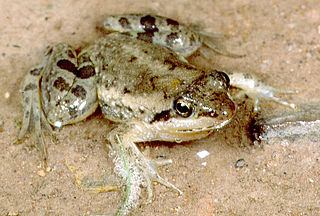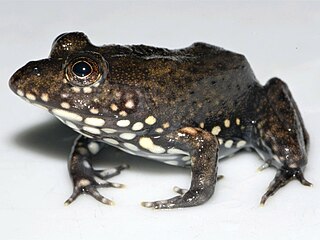
Scotobleps is a monotypic frog genus in the family Arthroleptidae; its sole species is Scotobleps gabonicus, sometimes known as the Gaboon forest frog or Gabon forest frog. It is found in eastern Nigeria, western and southwestern Cameroon, Equatorial Guinea, western Gabon, western Republic of the Congo, and western Democratic Republic of the Congo. Its range could extend into the Cabinda Enclave of Angola.

Phrynobatrachus bequaerti is a species of frog in the family Phrynobatrachidae. It is found in the mountains of north-western Burundi, eastern Democratic Republic of the Congo, and western Rwanda. The specific name bequaerti honours Joseph Charles Bequaert, a Belgian botanist, entomologist, and malacologist and who collected the holotype from Mount Vissoke. Common name Vissoke river frog has been coined for this species.

Phrynobatrachus calcaratus, the Boutry river frog or Peters' puddle frog, is a species of frog in the family Phrynobatrachidae. It is widely distributed in West Africa and Middle Africa. However, this nominal species is a species complex consisting of several species.

Phrynobatrachus cricogaster is a species of frog in the family Phrynobatrachidae. It is found in the mountains of western Cameroon and southeastern Nigeria. Common name Nkongsamba river frog has been coined for it. The specific name cricogaster is derived from the Greek krikos for "ring" and gaster for "belly", in reference to the prominent ring pattern on its venter. Frogs in the family Phrynobatrachidae are also known as puddle frogs, since they are often found near puddles in sub-Saharan Africa.
Phrynobatrachus dalcqi is a species of frogs in the family Phrynobatrachidae. It is endemic to the eastern Democratic Republic of the Congo and only known from Fizi Territory in the South Kivu province. The specific name dalcqi honours "Professor A. Dalcq", presumably Albert Dalcq (1893–1973), a Belgian embryologist. Common names Kivu river frog and Dalcq's puddle frog have been proposed for it.
Phrynobatrachus graueri is a species of frog in the family Phrynobatrachidae. It is found in eastern Democratic Republic of the Congo, Rwanda, Uganda, and western Kenya. The specific name graueri honours Rudolf Grauer, Austrian explorer and zoologist who collected the holotype. Common names Rugege river frog and Grauer's puddle frog have been coined for it.
Phrynobatrachus hylaios is a species of frog in the family Phrynobatrachidae. It is known from southern Cameroon and western Republic of the Congo, although its range presumably extends into nearby Central African Republic, Equatorial Guinea, and Gabon. It was first described as a subspecies of Phrynobatrachus werneri. The common name Foulassi river frog has been coined for it.
Phrynobatrachus irangi is a species of frog in the family Phrynobatrachidae. It is endemic to Kenya and is known only from two localities, its type locality, the eponymous Irangi Forest on the south-eastern slopes of Mount Kenya, and Kimande on the south-eastern slopes of the Aberdare Range. Common name Irangi puddle frog has been coined for it.
Phrynobatrachus krefftii is a species of frog in the family Phrynobatrachidae. It is endemic to the Usambara Mountains in Tanzania, including both the West and East Usambaras and the Magrotto ridge. The specific name krefftii honours Paul Krefft, a German herpetologist and physician who made several expeditions to Africa. Common names Krefft's river frog and Krefft's puddle frog have been coined for it.
Phrynobatrachus pakenhami is a frog species in the family Phrynobatrachidae. It is endemic to Pemba Island off Tanzania. It is similar to Phrynobatrachus acridoides, its sister species, but the two species differ in ecology and male advertisement call. On the other hand, the recently described, supposed diminutive species P. nigripes was simply based on juveniles and subadults of P. pakenhami.
Phrynobatrachus parkeri is a species of frog in the family Phrynobatrachidae. It is endemic to the west-central and northeastern Democratic Republic of the Congo. It is only known from a few widely separated localities. It is similar to Phrynobatrachus acridoides(Cope, 1867), and it might be a synonym of the latter. The specific name parkeri honors Hampton Wildman Parker, an English zoologist and herpetologist. Common name Parker's river frog has been coined for it.

Phrynobatrachus parvulus is a species of frog in the family Phrynobatrachidae. It is widely distributed in the upland areas of Central and East Africa in Angola, northern Botswana, northern Zimbabwe, Zambia, southeastern Democratic Republic of the Congo, Malawi, and Tanzania. However, many identifications are problematic, and the taxonomic status of this species with respect to Phrynobatrachus mababiensis and P. ukingensis requires clarification; in the more inclusive species delimitation applied by the IUCN SSC Amphibian Specialist Group, also Uganda is tentatively included in the range of this species. Common names Loanda river frog, dwarf puddle frog, and little puddle frog have been proposed for this species.

Phrynobatrachus perpalmatus is a species of frog in the family Phrynobatrachidae. It is found in the area stretching from the central and southern Sudan southward through South Sudan and central/eastern Democratic Republic of the Congo, extreme western Tanzania, Burundi, Malawi, and Zambia to northern Mozambique; its range might extend into northern Zimbabwe. Common names Lake Mwero river frog and webbed puddle frog have been proposed for it.
Phrynobatrachus scapularis is a species of frog in the family Phrynobatrachidae. It is endemic to the northern and northeastern Democratic Republic of the Congo. The specific name scapularis refers to shoulder blades (scapulae). Common name Buta river frog has been coined for it.
Phrynobatrachus taiensis is a species of frog in the family Phrynobatrachidae. It is endemic to Ivory Coast and only known from its type locality, Taï Forest in the Taï National Park. There are concerns about taxonomic validity of this species. Common name Tai river frog has been coined for it.
Phrynobatrachus uzungwensis is a species of frogs in the family Phrynobatrachidae. It is endemic to eastern Tanzania and is known from the Udzungwa, Uluguru, Nguu, and Nguru Mountains. Common names Ukinga puddle frog and Udzungwa puddle frog have been coined for this species.
Phrynobatrachus versicolor is a species of frog in the family Phrynobatrachidae. It is found in northwestern Burundi, western Rwanda, southwestern Uganda, and adjacent eastern Democratic Republic of the Congo. Common names Rwanda river frog and green puddle frog have been coined for it. The specific name versicolor, derived from the Latin versare and color, and refers to its variable dorsal colouration.

Amnirana lepus is a species of frog in the family Ranidae. It is found in Cameroon, Equatorial Guinea, Gabon, Central African Republic, Republic of the Congo, Democratic Republic of the Congo, and northern Angola. Common names Andersson's Cameroon frog, Andersson's white-lipped frog, and jumping white-lipped frog have been proposed for it.

Aubria masako is a species of frog in the family Pyxicephalidae. It is found in southeastern Cameroon, eastern Gabon, southwestern Central African Republic, northern Republic of the Congo, and eastward to the central Democratic Republic of the Congo, with one (doubtful) record from Angola; it might occur in Equatorial Guinea. Common names Masako ball frog and Masako fishing frog have been coined for this species. Whether it is distinct from Aubria subsigillata has been debated, but at present it is treated as a valid species.

Phrynobatrachus jimzimkusi is a species of frogs in the family Phrynobatrachidae. It is found in submontane and montane regions within the Cameroon volcanic line as well as the adjacent Obudu Plateau in the southeast of Nigeria. It is named after James (Jim) Zimkus by his wife, Breda Zimkus, the first author of the species description. Common name Jim Zimkus' puddle frog has been proposed for this species.









